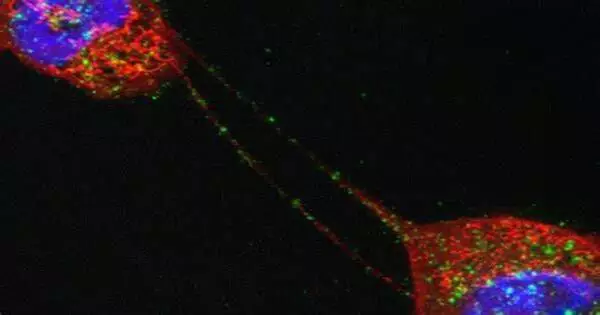Tunneling nanotubes (TNTs) or membrane nanotubes are cytoskeletal protrusions that extend from the plasma membrane and allow different animal cells to connect over long distances, sometimes over 100 μm between certain types of cells. These are thin, membranous structures that form between cells and allow direct communication and transfer of cellular components such as organelles, vesicles, and signaling molecules.
Tunneling nanotubes with a diameter of less than 0.7 micrometers, an actin structure, and the ability to transport portions of the plasma membrane between cells in both directions. These nanotubes play a role in intercellular communication and are thought to be an intriguing aspect of cell biology. Larger TNTs (>0.7 μm) have an actin structure with microtubules and/or intermediate filaments and can transport components such as vesicles and organelles, including whole mitochondria, between cells.
TNTs have diameters ranging from 0.05 m to 1.5 μm and can reach lengths of several cell diameters. TNTs have been observed in two varieties: open-ended and closed-ended. TNTs with open ends connect the cytoplasm of two cells. Because there is a gap junction cap that only allows small molecules and ions to flow between cells, closed ended TNTs do not have continuous cytoplasm.
Key features of tunneling nanotubes include:
- Structure: TNTs are bridge-like nanoscale structures that connect the cytoplasm of two adjacent cells. They can be quite long and have diameters ranging from 50 to 200 nanometers.
- Composition: TNTs are made up of lipid bilayers that resemble cell membranes and may contain cytoskeletal elements like actin or microtubules. The composition may differ depending on the cell types involved.
- Function: Tunneling nanotubes allow for the direct exchange of cellular components between cells that are connected. Organelles such as mitochondria, endoplasmic reticulum, lysosomes, and even small vesicles carrying signaling molecules or genetic material are included.
- Role in Health and Disease: TNTs have been observed in various cell types, including immune cells, neurons, and cancer cells. They play roles in processes such as immune response, tissue repair, and neuronal communication. However, their involvement in diseases, including cancer metastasis, neurodegenerative disorders, and viral infections, is an area of active research.
- Formation: The exact mechanisms of TNT formation are not fully understood, but they are believed to involve cytoskeletal rearrangements and the dynamic regulation of membrane components.
Significance
Tunneling nanotubes are a novel mode of cell-to-cell communication that contradicts the conventional view of cell signaling, which frequently involves soluble factors or direct cell-to-cell contact. Understanding the role of TNTs in health and disease has the potential to provide new insights into cellular processes and may have therapeutic implications.
These structures have been implicated in cell-to-cell communication, the transfer of nucleic acids like mRNA and miRNA between cells in culture or tissue, and the spread of pathogens or toxins like HIV and prions. TNTs have been observed to have lifetimes ranging from a few minutes to several hours, and several proteins, including many that interact with Arp2/3, have been implicated in their formation and inhibition.
















